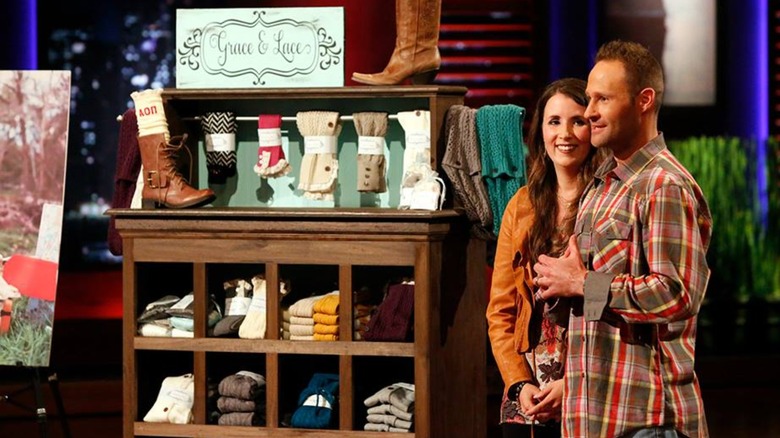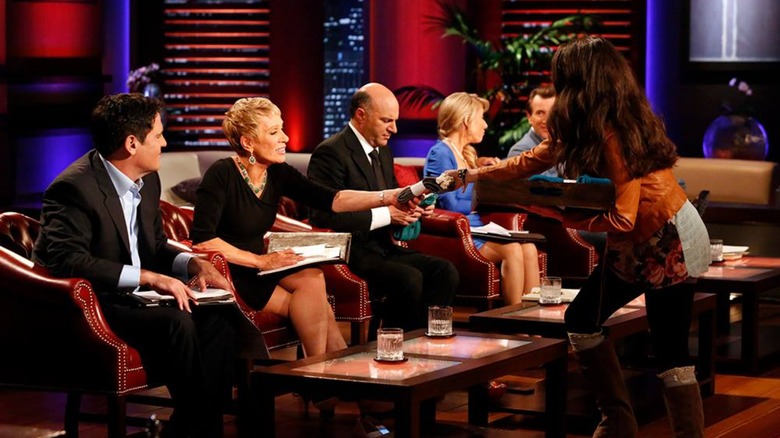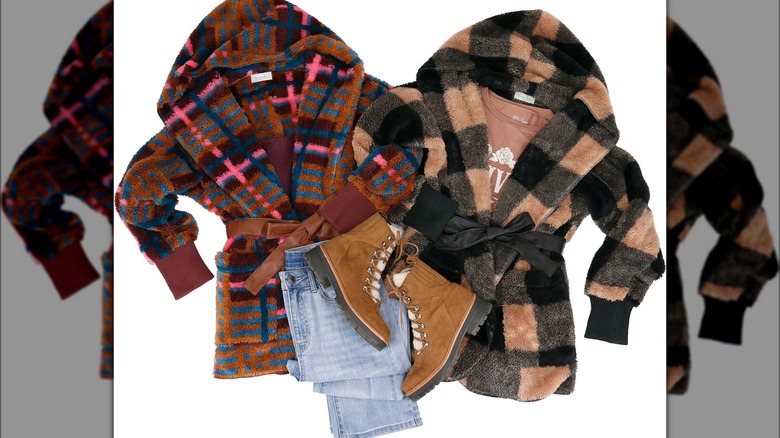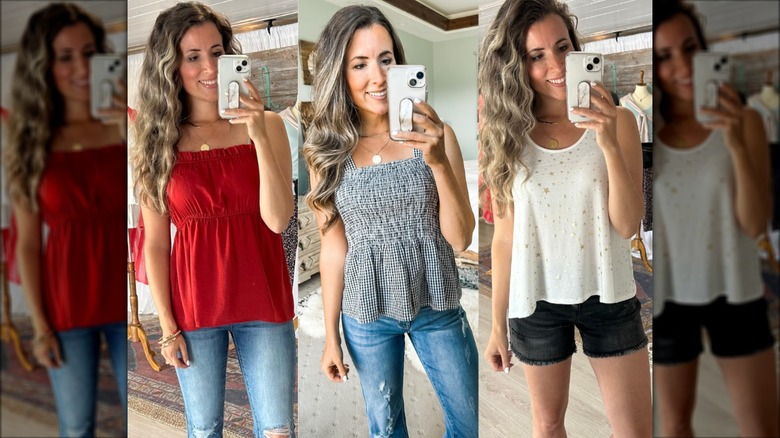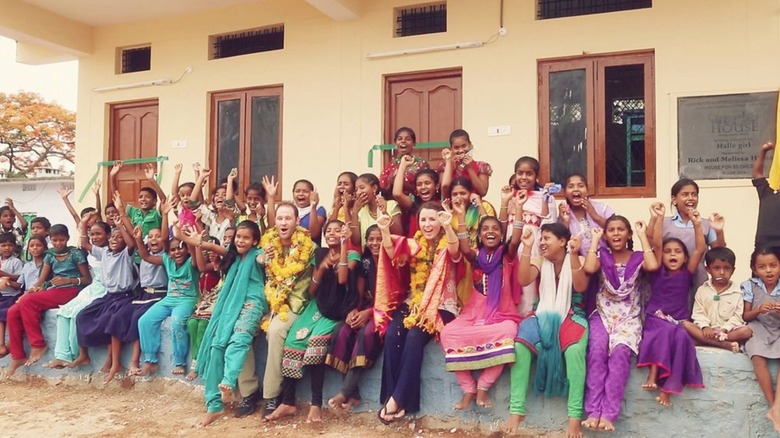Grace And Lace: What Happened To The Brand After Shark Tank?
Socks don't have to stay hidden. From knee-high socks to trendy printed and embellished styles, they deserve their share of the spotlight, and that's exactly what helped propel sock brand Grace and Lace. The company shot to fame after appearing on a 2013 episode of "Shark Tank," though it had already experienced some success before hitting national TV. According to an interview with Success, Grace and Lace began three years earlier when Melissa Hinnant suffered from pregnancy complications and was bedridden. There, she crocheted to pass the time and keep her hands busy.
Tragically, just two weeks after being ordered to limit her activity, Hinnant's daughter was delivered stillborn. Through the grief, Hinnant was compelled to continue knitting and crocheting, leading her to design one-of-a-kind socks and leg warmers. Eventually, strangers in public and friends on Facebook took notice of the frilly accessories and asked for pairs of their own. Hinnant opened a digital storefront to keep up with the demand, and just a little over one year later, she had racked up $850,000 in sales.
The following year, the founder and her husband, Rick Hinnant, walked onto the "Shark Tank" stage to pitch their business to the panel of investor "Sharks": Kevin O'Leary, Barbara Corcoran, Robert Herjavec, Lori Greiner, and Mark Cuban. The pitch led to one of the show's most tense negotiations — and arguably one of its most successful deals.
Grace and Lace won over several Sharks
During a Season 5 episode of "Shark Tank," Melissa and Rick Hinnant introduced their brand of socks, with its signature style being a tall boot sock adorned with lace and buttons. The entrepreneurs were seeking $175,000 in exchange for a 10% stake in their business. As Rick explained to the Sharks, the company was already growing: In the 12 months leading up to the taping, Grace and Lace had earned a stunning $1.125 million, but the pair hoped to receive additional funds to hire a strategic planner.
Barbara Corcoran complimented the socks' cashmere-like fabric and was shocked to learn they only cost $5 to make. Other Sharks were impressed by the company's margins and steady success. Corcoran offered $87,500 for 5% of the business, but only if another investor matched her bid. This prompted Kevin O'Leary to offer $175,000 for 20%, followed by Robert Herjavec offering the founders the exact deal they'd requested. Mark Cuban echoed this offer, but when the Hinnants didn't immediately accept, the investors grew frustrated and appeared to pressure the couple to make a decision.
It became clear that the founders had a favorite Shark in mind, and after a tense exchange, Corcoran revised her offer to $175,000 for a 10% stake, though half of the money would be a line of credit. The couple quickly accepted, and upon exiting the stage, Rick said, "We went with our gut and it worked out, with the exact partner that we wanted. Absolutely incredible, it couldn't have gone better."
Grace and Lace sales exploded overnight
Soon after the Grace and Lace founders shook Barbara Corcoran's hand on "Shark Tank," orders came pouring in. Within 24 hours of the episode's initial airing, 10,000 purchases were made, and the brand made $1 million in less than a week. As Melissa Hinnant explained in a clip from The 700 Club, this was an achievement that no other "Shark Tank" product had accomplished in such a short timeframe. She later admitted to Success, "I don't think we slept for a week." The married couple couldn't keep up with the enthusiastic response and reached out to Corcoran for help. "I remember sitting in the diaper aisle in Target to take a call from Barbara," Melissa recalled. Though the investor offered advice — and helped Grace and Lace beef up its staff and outside suppliers — the founders received hate mail from customers who expected their items more quickly than the company could produce them.
By the end of 2013, Grace and Lace had racked up $2.8 million in annual sales, Rick Hinnant revealed to ABC News, and the founders quickly made good use of their earnings. "The financial side is great, but the heart behind the company is what we're more passionate about [...] To have the ability to give back means everything to us," he explained. The Hinnants funded two orphanages within just months of appearing on TV and planned to open more soon after.
Is Grace and Lace still in business?
Years after gaining its initial fame on "Shark Tank," Grace and Lace is still in business, though it's no longer known solely for frilly socks. In fact, a full range of fashion and home products, from lightweight knits to jeans and even bedding, can be purchased on the brand's website.
In a 2016 "Shark Tank" follow-up clip, Melissa and Rick Hinnant appeared to still be working closely with Barbara Corcoran, and the company had expanded to include 47 employees and an intern. The founding couple also revealed that they'd built a total of seven orphanages in India and had plans to open schools next.
Besides its "Shark Tank" feature, Grace and Lace has appeared on "Today," "The View," and "Good Morning America," as well as in publications like "Cosmopolitan," "Forbes," and "Inc." In a 2021 video uploaded to Grace and Lace's YouTube channel, Rick revealed that the company had nearly reached $100 million in sales — a figure he hopes to one day double or even triple. The brand also maintains a loyal following on social media: It boasts 112,000 followers on Instagram and 276,000 followers on Facebook.
What's next for Grace and Lace?
Grace and Lace continues to grow and shows no signs of slowing down. Still, a 2022 blog post on the company's website noted that the first years of the COVID-19 pandemic were challenging, and while the business has mostly recovered, "obstacles still exist." That said, Grace and Lace seems to be persevering, with new product drops and launches happening pretty consistently.
The brand's continued success can largely be attributed to Melissa Hinnant's design strategy. On the brand's designs, she told Austin Woman, "I know every woman loves to be complimented, so I want to design things that when they're walking in the airport or on the street, someone stops them and says, 'Oh my gosh, what is that? Where'd you get that?'" This approach helped her sell her early sock designs, and it may still work going forward as she develops new statement sweaters, dresses, shoes, and other goods.
However, the Hinnants aren't only focused on product designs and sales margins — they're also motivated by their philanthropic work and a commitment to providing for their employees. "We find a way to keep forging on," Melissa told foundingAUSTIN. "It all comes back to the passion of how the business started, and why we started, and who the business is benefitting."
